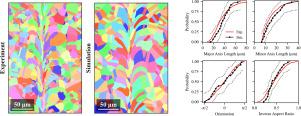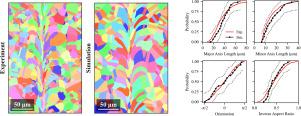On microstructure development during laser melting and resolidification: An experimentally validated simulation study
IF 8.3
1区 材料科学
Q1 MATERIALS SCIENCE, MULTIDISCIPLINARY
引用次数: 0
Abstract
Integrating experiment and simulation provides invaluable insights into the critical parameters that determine the microstructure of alloys produced by additive manufacturing. Here, the grain structure formation due to solidification during single pass laser scans (mimicking bead-on-plate single tracks) on a 316L stainless steel is studied in situ inside a scanning electron microscope that is directly integrated with a continuous-wave laser. The grain size distribution before melting is used as an initial condition in a coupled phase-field/thermal multiphysics modeling framework. The predicted resolidified microstructures are found to agree favorably with those observed experimentally for multiple laser powers and scan velocities, indicating the validity of the overall model. Grain morphology is analyzed quantitatively, and the top surfaces are compared between the experiments and simulations. Analysis of the three-dimensional grain shapes predicted by the simulations shows that the length of the major axis of the resolidified grains is sensitive to laser power and scan speeds, while the length of the minor axis is not. Furthermore, the preferential alignment of the major axes of the grains depends on the melt pool geometry.


激光熔化和分解过程中的微观结构发展:经实验验证的模拟研究
将实验与模拟相结合,可以深入了解决定增材制造合金微观结构的关键参数。在此,我们在与连续波激光器直接集成的扫描电子显微镜内,对 316L 不锈钢在单程激光扫描(模拟珠上板单轨)过程中由于凝固而形成的晶粒结构进行了现场研究。熔化前的晶粒尺寸分布被用作相场/热多物理场耦合建模框架的初始条件。结果发现,在多种激光功率和扫描速度下,预测的分解微结构与实验观察到的微结构非常吻合,这表明了整个模型的有效性。对晶粒形态进行了定量分析,并对实验和模拟的顶面进行了比较。对模拟预测的三维晶粒形状的分析表明,解析晶粒的主轴长度对激光功率和扫描速度敏感,而次轴长度则不敏感。此外,晶粒主轴的优先排列取决于熔池的几何形状。
本文章由计算机程序翻译,如有差异,请以英文原文为准。
求助全文
约1分钟内获得全文
求助全文
来源期刊

Acta Materialia
工程技术-材料科学:综合
CiteScore
16.10
自引率
8.50%
发文量
801
审稿时长
53 days
期刊介绍:
Acta Materialia serves as a platform for publishing full-length, original papers and commissioned overviews that contribute to a profound understanding of the correlation between the processing, structure, and properties of inorganic materials. The journal seeks papers with high impact potential or those that significantly propel the field forward. The scope includes the atomic and molecular arrangements, chemical and electronic structures, and microstructure of materials, focusing on their mechanical or functional behavior across all length scales, including nanostructures.
 求助内容:
求助内容: 应助结果提醒方式:
应助结果提醒方式:


